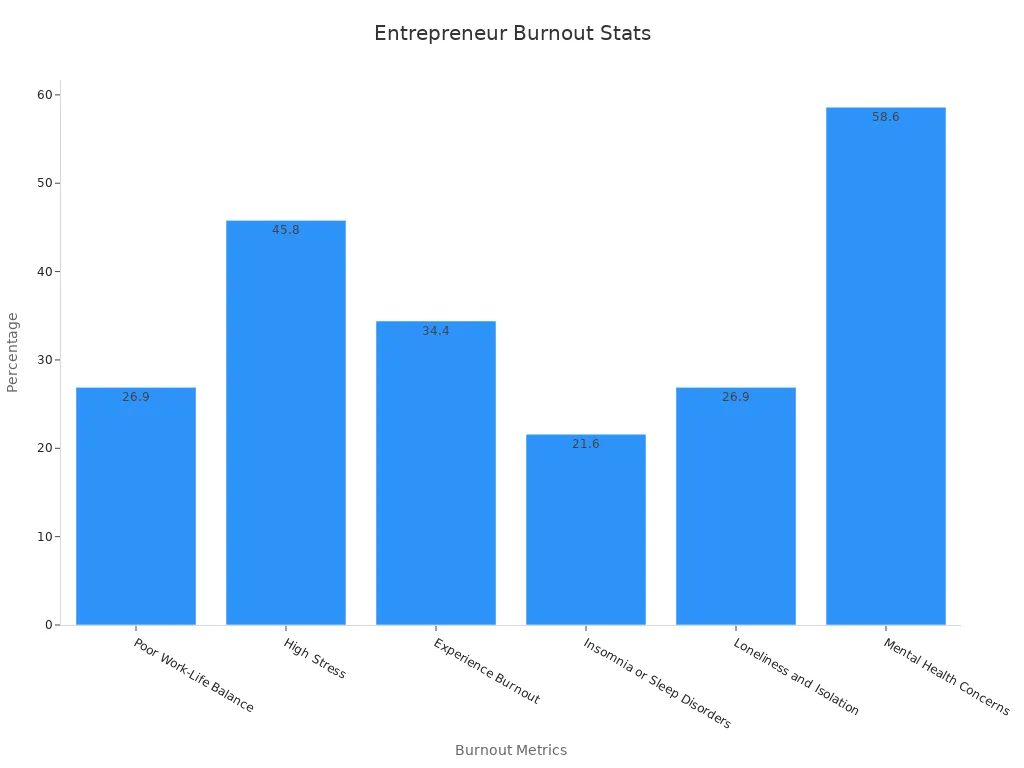How to Start and Run a Successful One-Man Company

Running a one man company gives you freedom and control. You set your schedule, make choices, and follow your ideas. Around the world, small businesses are everywhere. They make up 90% of companies and provide over 50% of jobs. By starting your own one man company, you join 400 million others like you. Many owners feel happy, with 39% saying they are "very happy." Additionally, 92% say they don’t regret their choice. With hard work and helpful tools, like a good website, you can make your one man company a success.
Understanding a One-Man Company
What is a One-Man Company?
A one-man company is a business run by one person. You handle everything, like making decisions and doing daily tasks. It’s easy to start and lets you control how things work. You can offer services, sell items, or make digital content. A one-man company helps you turn your talents into a business you own.
Benefits of Running a One-Person Business
Running a one-person business has many perks. You can choose your hours and work on things you enjoy. Many people value this freedom more than earning extra money. Studies show self-employed people care about flexibility five times more than income.
You also feel proud and in charge. Research says 61% of self-employed people are happy with their work. Plus, 96% like their lifestyle and don’t want regular jobs. This happiness comes from making your own choices and seeing your hard work pay off.
Statistic | Value |
|---|---|
Self-employed people happy with their work | 61% |
Top reasons for self-employment | Control, pride, money |
Choosing flexibility over earning more | 5 times more |
Self-employed people who don’t want regular jobs | 96% |
Common Myths About Successful One-Person Businesses
Some think one-person businesses can’t succeed or last long. But that’s not true. Over 60% of small firms with workers have fewer than five employees. This proves small businesses, including one-person ones, are important to the economy.
Another myth is needing a big team to do well. Actually, solopreneurs succeed by using tools that make work easier. Platforms like Momen help you manage your business without needing tech skills. By focusing on what you’re good at and using helpful tools, you can grow a strong one-man company.
Tip: Don’t believe myths. With effort and smart planning, you can succeed as a solopreneur.
Steps to Start a One-Person Business
Finding the Best Business Idea
Picking the right idea is key to your business. Look at your daily life. What problems do you notice? For example, Airbnb started by renting air mattresses to solve housing issues. Spanx began with footless pantyhose, filling a fashion need.
Pay attention to what people complain about. Problems often show chances to create solutions. Study your industry and competitors. Find gaps or areas to improve. For instance, Warby Parker made glasses affordable by selling them online.
Think about your skills and what you enjoy. A business based on your passion is more likely to succeed. Watch for new trends in technology and customer habits. These can spark creative ideas.
A good business idea solves problems, has clear customers, and stands out. It should also grow and make money.
Doing Market Research
Market research helps you know your audience and improve your idea. First, figure out who your customers are. What do they want? Use surveys, interviews, or online tools to learn more.
Organize your data for better results. Studies show sorting data improves accuracy by 35% and cuts errors by 40%. Focused campaigns also get 25% more responses.

Look at trends and competitors. Search for unmet needs in the market. For example, Glossier turned a beauty blog into a skincare brand by solving customer problems. Use this knowledge to make your business stand out.
Choosing the Legal Setup
Picking the right legal setup is an important step. Choose what fits your needs. Common choices are sole proprietorship, LLC, or corporation. A sole proprietorship is simple and great for one-person businesses.
Register your business name and get any needed licenses. Check local rules to follow the law. For example, selling products might require a sales tax permit.
Open a separate bank account for your business. This keeps money organized and makes taxes easier. Get insurance to protect your business. Most solopreneurs need liability insurance.
Tip: Talk to a legal or financial expert to pick the best setup for your business.
Creating a Business Plan
A good business plan is like a map. It shows your goals, strategies, and steps to reach them. Writing one helps you stay focused and avoid mistakes. Businesses with plans grow faster and last longer than five years.
First, decide your business model. Think about what you’ll sell, who your customers are, and how you’ll help them. For instance, if you offer graphic design, your model could focus on custom designs for small companies.
Then, set clear money goals. List costs, prices, and how much you expect to earn. This shows how much money you need to start and keep your business running.
Add a marketing plan. Explain how you’ll find customers and promote your work. Will you use social media, emails, or team up with others? A strong plan helps you succeed.
Check your plan often. Update it as your business grows or things change. Businesses with plans are more likely to succeed when starting out.
Statistic Description | Value |
|---|---|
Growth rate of businesses with strategic plans | |
Likelihood of success in the first few years | Over 50% fail in year one, 44% fail by year three |
Increase in likelihood of starting a business with a plan | 260% more likely |
Survival rate beyond five years with a strategic plan | 70% survive |
Tip: Keep your plan simple but detailed. It should guide your choices and keep you focused.
Building an Online Presence
Your online presence is like your digital store. It helps you connect with customers and show your services. Today, every one-person business needs a strong online presence.
Start by making a professional website. Use tools like Momen to create one without coding. Add clear details about your business, services, and contact info. Make it easy for visitors to find what they need.
Use social media to talk to your audience. Post updates, answer questions, and share your services. Platforms like Instagram and LinkedIn help you find new customers and build trust.
Track your online performance with analytics. Website analytics show how visitors use your site. Social media analytics reveal how people interact with your posts. Together, they help you improve your online strategy.
Working on your online presence boosts visibility and customer interest. It’s not just about being online—it’s about standing out.
Note: Your online presence is a long-term project. Keep it updated and stay active to grow your business.
Tools and Resources for Running a One-Person Business

Productivity and Time Management Tools
Managing time well is very important for one-person businesses. Productivity tools help you stay on track and finish tasks faster. For instance, Asana helps organize work better. A small agency using Asana finished 35% more projects. TrackingTime is another tool that tracks hours and focuses on key tasks. A freelance designer saved 10 hours weekly with it and gained more clients.
Apps like Todoist or Trello can also help plan your day. These tools make sure you focus on important tasks and meet deadlines. By using these tools, you can grow your business while keeping a good work-life balance.
Accounting and Financial Management Software
Tracking money is a must for solopreneurs. Accounting software makes it easy to manage income, spending, and taxes. QuickBooks and FreshBooks are great options. They help create invoices, track payments, and handle cash flow easily.
Budgeting apps like Mint help you watch spending and set goals. These tools spot problems early and improve inventory tracking. They also build customer trust by ensuring clear billing. With the right tools, you can manage your money well and avoid big mistakes.
Marketing and Social Media Platforms
Marketing helps you find customers and grow your brand. Social media sites like Instagram, Facebook, and LinkedIn let you connect with people and share your services. These platforms give useful data to measure success:
Metric | Description |
|---|---|
Reach | How many people saw your content. |
Impressions | How often your content was shown, even if not clicked. |
Engagement | Actions like likes, shares, and comments on your posts. |
Lead Generation | Attracting and keeping potential customers interested. |
This data helps you improve your marketing and keep customers. Canva lets you make great visuals, and Hootsuite helps schedule posts and manage accounts. A strong online presence builds trust and helps your business succeed.
Outsourcing and Collaboration Tools
Managing a one-man company means doing many jobs yourself. Using outsourcing and collaboration tools can make your work easier. These tools let you focus on growing your business while experts handle specific tasks or processes are automated.
Outsourcing helps you get skills you don’t have. For example, in 2023, 65% of companies outsourced to gain expert help. This method ensures good-quality work and sparks new ideas. The global IT outsourcing market is expected to hit $777.74 billion by 2028, showing its rising importance for all businesses.
Collaboration tools boost teamwork and efficiency. A 2023 Owl Labs report found 81% of remote workers are more productive with these tools. Apps like Slack, Microsoft Teams, and Google Workspace keep you connected with freelancers or clients. Since 2019, the use of these tools has grown by 44%, proving their value for online teams.
Here’s a summary of key facts about outsourcing and collaboration tools:
Statistic | Insight |
|---|---|
7.7% CAGR | Outsourcing is expected to grow a lot by 2030. |
65% | Companies outsource to get skills they don’t have. |
81% | Remote workers work better with collaboration tools. |
44% | Use of collaboration tools grew by 44% since 2019. |
$777.74 billion | Global IT outsourcing market value by 2028. |

Outsourcing also saves time and money. For example, 37% of small businesses outsource at least one task to save costs and find skilled workers. Cloud services make outsourcing even better, with 93% of companies using them for improved results.
By using outsourcing and collaboration tools, you can simplify your work, get more done, and grow your business. These tools help you achieve more without feeling stressed.
Tip: Start small by outsourcing simple tasks or trying free collaboration tools. Add more as your business grows.
Inspiring One-Man Business Ideas

Service-Based Business Opportunities
Service businesses let you earn money using your skills. These focus on helping customers directly. For example, you could start cleaning, tutoring, or personal training. People often like hiring individuals for personal attention. This makes service businesses a smart choice for solo workers.
You might also try consulting. If you're skilled in a field, you can guide others. For instance, marketing consultants help small businesses advertise better. Using tools like scheduling apps can help you stay organized and provide great service.
About 65% of new businesses make money in their first year. This shows service businesses can succeed. Also, 77% of small business owners feel positive about the future. These trends make service-based ideas worth exploring.
Digital and Online Business Models
Online businesses let you work from anywhere. These include e-commerce, blogging, or teaching online courses. Selling items on Etsy or Amazon is popular. You could also sell eBooks or video lessons online.
Starting online often costs less money. You can begin small and grow as you gain customers. Many solo workers use social media to promote their products. Tools like Momen help you create websites easily, even without coding.
In 2023, over 5.1 million new businesses started in the U.S. This shows more people are becoming entrepreneurs. Half of small business owners plan to grow their businesses. If you like working online, this could be a great option for you.
Creative and Freelance Ventures
Creative and freelance work lets you turn talents into income. Freelancing includes jobs like writing, designing, or photography. Platforms like Upwork and Fiverr connect you with clients worldwide.
Creative businesses focus on unique products or services. For example, you could sell handmade crafts or custom art. Many people love original items, making creative work rewarding. Freelancing also lets you pick projects you enjoy.
The freelancing market is growing as more people need special skills. Apps for teamwork help you manage tasks and deliver great results. If you like working alone, freelancing can be a satisfying career.
Statistic Description | Value/Percentage | Year | Source |
|---|---|---|---|
Profitability among new businesses | 65% | 2024 | |
Economic optimism | 77% | 2024 | |
Business expansion plans | 50% | 2024 | |
New business applications | 5.1 million | 2023 |
Tip: Pick a business idea that fits your skills and passions. This helps you stay motivated and succeed.
Niche Product-Based Businesses
Niche businesses sell special items for specific customer groups. These businesses succeed by meeting needs big companies ignore. Focusing on a smaller audience helps you gain loyal customers and stand out.
Online shopping makes starting a niche business simple. You can sell to people worldwide and match their preferences. Making customers feel special builds loyalty. Happy customers return and tell others about your business. Using third-party logistics (3PL) ensures fast deliveries and keeps customers satisfied. E-commerce tools also show customer habits, helping you adjust to trends.
Choose a product that solves a problem or meets a unique need. For example, eco-friendly candles or custom pet portraits attract niche buyers. Platforms like Etsy or Shopify help display your products. Social media is great for sharing your story and finding customers.
Keep things easy to manage. Start small and grow as demand increases. Work with good suppliers and use tools like Momen to make a professional website. A clear website shows your products and builds trust with buyers.
Running a niche business lets you turn your passion into income. Focus on quality, personal touches, and happy customers to succeed in today’s market.
Overcoming Challenges in Running a One-Person Business
Managing Time and Avoiding Burnout
Running a one-person business means doing many jobs alone. This can cause stress if not handled well. To stay balanced, plan your tasks and separate work from personal time. Make a daily schedule with breaks included. Use tools like planners or time trackers to stay focused on key tasks.
Burnout is common for solopreneurs. Research shows 34.4% feel burned out from long hours. Poor work-life balance affects 26.9%, and 21.6% have trouble sleeping. To avoid this, try self-care activities. Light exercise (64.3%), meditation (38.3%), or reading (48%) can help you relax and regain energy.

Tip: Use tools like Momen to automate tasks. This saves time and lowers stress.
Balancing Multiple Roles Effectively
In a one-man company, you handle all tasks, like marketing and customer service. To manage this, focus on your main duties and outsource smaller tasks. For example, hiring help for IT or accounting gives you more time to grow your business.
Automation tools are also useful. Apps for scheduling, email marketing, or project management make work easier. These tools let you focus on growing your business instead of repetitive tasks.
Here are some tips to manage your time better:
Do the most urgent tasks first.
Automate simple, repeated jobs.
Save some profits for emergencies to reduce money worries.
Note: To stay ahead, focus on what makes your business special.
Combating Loneliness and Isolation
Working alone can feel lonely, but connecting with others helps. Join local groups or online forums to meet people like you. Peer groups and mentors can guide you and improve your mental health.
Building connections turns loneliness into teamwork. Attend events or webinars to meet others. Use LinkedIn to connect with other solopreneurs and share ideas.
Evidence | Description |
|---|---|
Networking and community support | Helps reduce loneliness and mental health struggles. |
Peer support groups and mentorship | Offers advice and a place to share challenges. |
Building a network | Changes isolation into teamwork and support. |
Designing your business to match your passions also helps. This keeps you motivated and connected to your goals.
Tip: Plan social activities or co-working days to stay connected with others.
Scaling a Successful One-Person Business
Growing your one-person business needs smart planning and strategies. You don’t need a big team to grow. Instead, focus on reaching more people, working smarter, and earning more while staying in control.
1. Automate Repetitive Tasks
Automation tools save time and reduce effort. Use apps for tasks like sending invoices, marketing emails, or helping customers. For example, scheduling apps can organize meetings, and email tools keep your audience updated. Automating these tasks gives you more time to grow your business.
2. Diversify Your Offerings
Adding new services or products can bring in more customers. For instance, if you do graphic design, try selling templates or teaching online classes. Offering different things helps you reach new people and earn more. Start small and test ideas before expanding.
3. Leverage Partnerships
Working with other businesses can create new chances. Team up with brands that match your work to share resources or promote each other. For example, a writer could partner with a web designer to offer full website packages. Partnerships let you grow without adding too much work.
4. Focus on Customer Retention
Keeping current customers is easier than finding new ones. Provide great service and check in with them often. Offer loyalty rewards or discounts to encourage them to return. Happy customers will tell others, helping your business grow naturally.
5. Use Scalable Tools
Choose tools that grow with your business. Platforms like Momen help you create and manage websites without coding. These tools handle more work as your business grows, keeping things running smoothly.
Tip: You don’t have to do everything alone. Use tools and partnerships to grow smarter.
Starting and running a one-person business might seem hard, but it’s possible with the right steps. Start by picking a good business idea, learning about your market, and choosing the best legal setup. Create a simple business plan and build an online presence to reach customers. Use tools to manage your time, money, and marketing wisely.
You can measure success in a one-person business. Numbers like profit margin, customer loyalty, and website visitors show how well you’re doing. The table below lists important things to track:
Metric | What It Shows |
|---|---|
Gross profit margin | How much money you keep after paying for products. |
Customer retention rate | How many customers stay with you over time. |
Daily web traffic users | How many people visit your website each day. |
Recurring revenue | Money earned from repeat customers, often in subscription-based businesses. |
Net promoter score (NPS) | How likely customers are to recommend your business to others. |
With the right attitude and tools, you can handle challenges and reach your goals. Start today and turn your ideas into a successful business.
FAQ
How do I pick a good business idea?
Find problems in your daily life to solve. Check for market gaps or needs people have. Match your skills and hobbies with what customers want. A great idea should be easy to start, make money, and be something you love doing.
How can I manage time well as a solo worker?
Use apps like Trello or Asana to plan tasks. Focus on the most important jobs first. Automate simple tasks with helpful tools. Take breaks often to stay fresh. Staying organized and focused helps you get more done faster.
Is having a website important for my small business?
Yes, a website makes your business look trustworthy. It also helps people find you online. Use tools like Momen to make a site easily without coding. Add details about your services, contact info, and reviews. A good website helps your business grow.
How can I grow my business without hiring anyone?
Use software to automate tasks and hire experts for special jobs. Keep your current customers happy and add new products or services. Work with other businesses to share ideas and resources. Use tools like Momen to grow while staying in control.
What if I feel lonely running my business alone?
Join local groups or online forums to meet others. Go to events or webinars to connect with people. Plan co-working days or team up with freelancers. Talking to others helps you feel less alone and keeps you motivated.
See Also
Essential Guide to Assembling Your Winning Startup Team
Strategies for Solo Founders to Successfully Launch Startups
Launching Your Successful Startup in 2025: A Complete Guide
